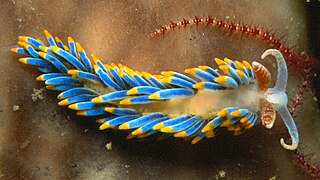
Nudibranchs belong to the order Nudibranchia, a group of soft-bodied marine gastropod molluscs that shed their shells after their larval stage. They are noted for their often extraordinary colours and striking forms, and they have been given colourful nicknames to match, such as "clown", "marigold", "splendid", "dancer", "dragon", and "sea rabbit". Currently, about 3,000 valid species of nudibranchs are known.

The Spanish dancer, scientific name Hexabranchus sanguineus, is a dorid nudibranch, a very large and colorful sea slug, a marine gastropod mollusk in the family Hexabranchidae.The taxonomy of the genus Hexabranchus has been controversial but a thorough molecular and morphological study published in 2023 showed that the name H. sanguineus was being used for at least 5 distinct species.

Chromodoris willani, commonly known as Willan's chromodoris, is a species of sea slug, a dorid nudibranch, a shell-less marine gastropod mollusk in the family Chromodorididae. The species is named for the renowned nudibranch taxonomist Dr. Richard C. Willan.

Chromodoris annae also known as the Anna's magnificent sea slug is a species of sea slug, a very colourful nudibranch, a shell-less marine gastropod mollusc in the family Chromodorididae.

Chromodoris magnifica, also known as the magnificent sea slug is a sea slug, a species of nudibranch, a shell-less marine gastropod mollusc in the family Chromodorididae. It is the type species of the genus Chromodoris.
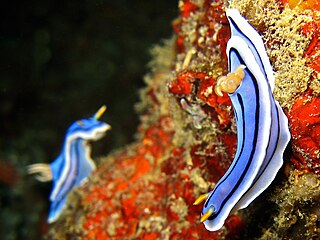
Chromodoris is a genus of very colourful sea slugs or dorid nudibranchs, marine gastropod molluscs, and the type genus of the family Chromodorididae. Within the genus Chromodoris, there are currently 101 classified species. Species within Chromodoris are commonly found in tropical and subtropical waters, living as members of reef communities and preying primarily on sponges. A molecular phylogeny of the family Chromodorididae resulted in this genus being restricted to a smaller number of species than formerly, most of which have longitudinal black lines on the mantle. Many former members of Chromodoris were transferred to Goniobranchus
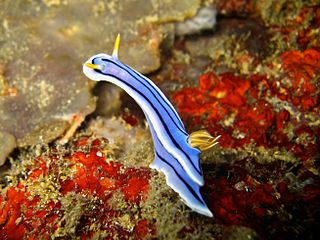
Chromodoris lochi, common name Loch's chromodoris, or Loch’s chromodoris slug, is a species of colourful sea slug, a dorid nudibranch, a marine gastropod mollusk in the family Chromodorididae.

Doriprismatica atromarginata is a species of sea slug. It is a dorid nudibranch, a shell-less marine gastropod mollusk in the family Chromodorididae.

Chromodoris joshi is a species of sea slug. It is a dorid nudibranch, a shell-less marine gastropod mollusc in the family Chromodorididae.

Ceratosoma amoenum, or the clown nudibranch, is a species of colorful dorid nudibranch, a sea slug, a shell-less marine gastropod mollusk in the family Chromodorididae.
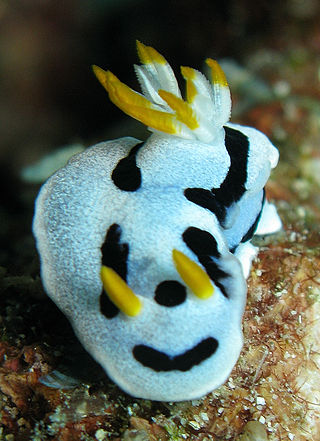
Chromodoris dianae is a species of sea slug, a dorid nudibranch, a shell-less marine gastropod mollusc in the family Chromodorididae.
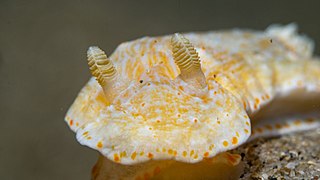
Goniobranchus epicurius is a species of colourful sea slug called a dorid nudibranch, a marine gastropod mollusc in the family Chromodorididae.

Chromodoris michaeli is a species of colourful sea slug, a dorid nudibranch, a marine gastropod mollusk in the family Chromodorididae.
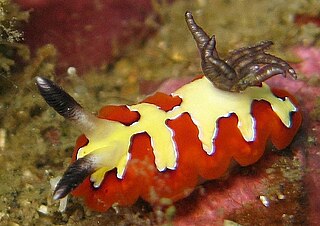
Goniobranchus fidelis, also commonly known as the faithful sea slug, is a species of colourful sea slug, a dorid nudibranch, a marine gastropod mollusc in the family Chromodorididae.

Goniobranchus tumuliferus is a species of colourful sea slug, a dorid nudibranch, a marine gastropod mollusc in the family Chromodorididae.

Goniobranchus rubrocornutus is a species of colourful sea slug, a dorid nudibranch, a marine gastropod mollusc in the family Chromodorididae.

Goniobranchus sinensis is a species of colourful sea slug, a dorid nudibranch, a marine gastropod mollusc in the family Chromodorididae.
Hypselodoris placida is a species of sea slug or dorid nudibranch. It is a marine gastropod mollusk in the family Chromodorididae.
Mexichromis circumflava is a species of sea slug or dorid nudibranch, a marine gastropod mollusk in the family Chromodorididae.

Goniobranchus leopardus, is a species of colourful sea slug, a dorid nudibranch, a marine gastropod mollusc in the family Chromodorididae.





















